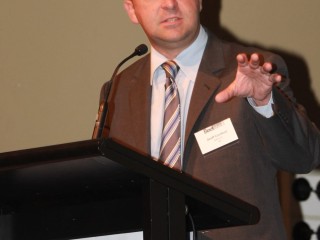 Significant changes are afoot within animal welfare regulation in Australia, including a shift from voluntary to mandatory processes, which will inevitably affect all sectors of the beef industry.
Significant changes are afoot within animal welfare regulation in Australia, including a shift from voluntary to mandatory processes, which will inevitably affect all sectors of the beef industry.
How this will impact on the feedlot sector was discussed during yesterday’s Australian Lot Feeders Association annual conference in Toowoomba.
ALFA councillor Geoff Cornford told the gathering that in the case of feedlots operating under National Feedlot Accreditation Scheme guidelines, most of the requirements for animal welfare were already addressed within the system. For outliers, however, adjustments would inevitably be necessary.
The general manager of the North Australian Pastoral Co’s Wainui feedlot on the Darling Downs, Mr Cornford sits on ALFA’s animal welfare sub-committee. He said feedlot animal welfare standards were regulated by two main bodies – State Government level, where each state had prevention of animal cruelty legislation, and below that, a self-regulation process administered within industry.
“As was also demonstrated in other areas of management, the feedlot industry was proactive in early development of welfare standards, which were included in the original version of national guidelines for beef cattle feedlots in Australia,” he said.
“When the new Animal Welfare code of practice was published, basically it took the feedlot sector’s guidelines and they became part of the Australian code of practice for the welfare of cattle. This is a reference document under NFAS currently, sitting beside some sector-specific welfare requirements within the NFAS program.”
As part of a Federal Government initiative, a number of new welfare standards were being established for each of the animal production sectors in Australia, in addition to other areas including wildlife and companion animals. The set of standards and guidelines for cattle was one of these.
“While it was adopted as a component within NFAS, the original code of practise was voluntary,” Mr Cornford said. “However the distinction within the new standards and guidelines, is that the standards component will be adopted within state legislation, making it a legal requirement to follow them,” he said.
“That’s a significant distinction, but for those feedlots that operate under NFAS, it means no real change in an operational sense.”
The guidelines component of the document could be adopted by industry within quality assurance systems, or other means, he said.
A draft of the new standards and guidelines for cattle was being prepared by writing and reference groups, including all the different stakeholders engaged in animal welfare issues.
The writing group included Federal/State Government, producers, and the scientific community. Its role includes identifying welfare aspects associated with husbandry and handling issues, which are then scientifically reviewed and prepared as discussion papers for the reference group. From that, draft standards and guidelines are prepared.
At the end of the development process the standards and guidelines would go for public consultation, and a regulatory impact statement developed. Once delivered in an acceptable form, it would then be tabled for State Governments’ endorsement and legislation.
Mr Cornford said ALFA had adopted several principles throughout the development process.
“We saw it as an opportunity to modernise a number of the existing code of practice standards. An example surrounds feeding, which under the code of practice has a statutory requirement on the amount of bunk space provided for cattle. That will be removed, in recognition that it is the quantity and quality of feed that is the more relevant matter in meeting the welfare requirements of cattle.”
“Another important point is that we see this process as an opportunity to move the animal welfare standards up to a point where they are more consistent with NFAS,” Mr Cornford said.
“For any NFAS-accredited feedyard, there will be very little if any change to operations under the new system. For non-accredited yards, however, there may be significant change required to meet the new standards and guidelines.”
One of the big challenges in the process had been in achieving consensus on the content of the standards among different state authorities, he said. This had stalled the entire process for a year, but discussions had re-commenced in August, and were now being progressed.
“Perhaps by the end of 2012 there may be some agreement on the draft standards and guidelines – but that is just the first stage of implementation,” Mr Cornford said.
- • During the ALFA annual general meeting yesterday afternoon, Kerwee feedlot general manager Jim Cudmore was reinstated for a third term as president. Replacing outgoing councillors Grant Garey (Teys Australia, Jindalee, NSW), Steve Reynolds (Elders, Charlton, Victoria) and Duncan Sturrock (Launcells feedlot, Drillham, Qld); will be new councillors Bryce Camm (Wonga Plains, Dalby, Qld); Tony Fitzgerald (Elders, Killara NSW) and Paul Vogt (independent feedlot, South Australia).



HAVE YOUR SAY